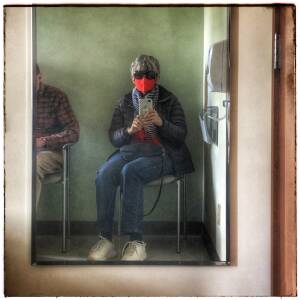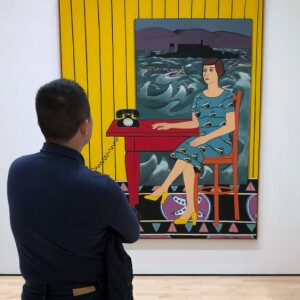A Day in the Big City
It starts off smartly, with a drive up the coast on a bright crisp morning, the sparkle of the ocean on the left, fields of electric yellow mustard rippling on the right, everything vibrant and polished by the recent storms. We are headed to the Joan Brown exhibit (Extra) at SF MOMA; she is my generation, and I am curious about her painting, about her place in the Bay Area art scene.
We haven’t been to the museum neighborhood in years. Hard to say with Covid leaving its sticky fingerprints all over everything—years, months, a lifetime? Covid’s on my mind since a good friend went into the hospital earlier this week, but I digress. How we used to love walking the downtown streets—all that shiny glass and bustle, the surprise of a little green park tucked between tall reflective buildings, that particular charged current of an urban afternoon. Today we got grit, and so many grim empty spaces for rent, blank windows, restaurants vanished, construction cranes breaking the skyline, but to what end. Anything unique is being gutted. We build and build and people still wander the streets with their belongings piled high in rusty carts. Desperate looking characters hang around the bright green rental scooters, simply sitting on them, claiming a piece of real estate, staring at the sidewalk.
We come to a discount department store at the intersection of several busy streets. There is a long line of people waiting to get in. I wonder if there is a special sale, some kind of celebrity event, a signing, a sighting. Folks are being let in a few at a time, as others leave the store. There are security guards. But it is a regular shopping day. Business as usual, meaning shoppers are monitored from the time they enter the building. Two leave, two others can go in. “It gives us a chance to see who we’re dealing with,” comments the guard. Too much theft. No consequences. So customers are tallied, watched, and there is a line of people who still need to buy underwear or towels or whatever it is that they’re after. There are no other stores for blocks, and certainly none that offer anything basic or remotely affordable. We are only a few streets from the shopping mecca of Union Square, where presumably you can wander freely through the aisles of those destination stores, but we don’t go to check.
There is a horde of orange-vested ambassadors roaming these streets, presumably to mitigate the depressing effects of wandering these once vital corridors and finding more shuttered shops. “We welcome people, “ one says, “and give directions.” I try to look through a tourist’s eyes, and think who would ever want to come here? The sun doesn’t reach these corridors. We find only grubby little food counters instead of restaurants, so we circle back to the museum, knowing we can take a pleasant break in the lunch place upstairs. But it’s closed on Thursdays. How random is that? Not a sandwich in sight, but you can have a meal in the upscale place downstairs, whose sole advantage seems to be proximity. And the charming coffee bar with its little cups of espresso is closed as well. Permanently. Vanished from its perch in the atrium. But you can have coffee in a paper cup over there on the mezzanine.
At least Joan Brown was a remarkable painter, reinventing herself over the decades, always changing, experimenting, working from the heart. I appreciate how she was able to hold her own in the art world at a time that was not always inclusive of women.
But we couldn’t wait to get home. It’s the first time I’ve ever been to the city and not longed to linger a bit more—wouldn’t it be fun to stay for a few days, a week, and explore a neighborhood? can’t you imagine living here, if only for a month or two, long enough to get to know the bus routes and the hole-in-the-wall restaurants?
Alas, no. I am left with a terrible sadness, a longing for times and places gone by, a fear for the future, and a deep gratitude for home.


Comments
Sign in or get an account to comment.


